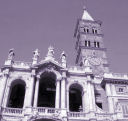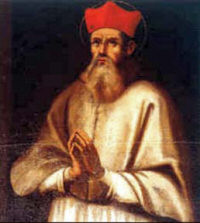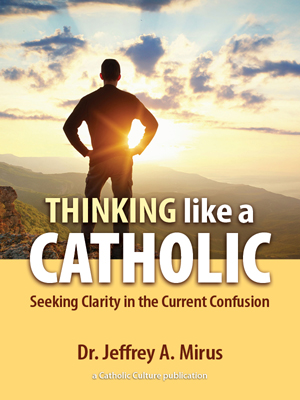Lent: February 21st
Wednesday of the First Week of Lent; Opt. Mem. of St. Peter Damian, Bishop & Doctor; Ember Wednesday
» Enjoy our Liturgical Seasons series of e-books!
The Church celebrates the Optional Memorial of St. Peter Damian, a man of vehemence in all his actions who was brought up in the hard school of poverty, found that he had the vocation of a reformer. He exercised it in the first place against himself as one of the hermits of Fontavellana in about 1035, but he did not remain for long hidden in his cell: his colleagues soon made him their abbot (1043). In 1057, Stephen IX made him Cardinal Bishop of Ostia. By his preaching and writings he was one of the valuable collaborators of the eleventh century popes in their great work of reform. Pope Leo XII declared him a Doctor of the Church in 1823.
Today is Ember Wednesday, the beginning of the Spring or Lent Embertide. There are two principal objects for the Ember Days of this period of the year: the first is to offer to God the season of Spring, and, by fasting and prayer, to draw down His blessing upon it; the second is to ask Him to enrich with His choicest graces the priests and sacred ministers who are to receive their Ordination on Saturday. See also Contemporary Observation of Ember Days and Lenten Ember Days for more information.
Meditation on the Liturgy
The people of Nineveh are also our model for Lent. They did penance at the preaching of Jonah the prophet and obtained divine mercy and pardon. Christ is preaching penance to use today through his Church. Should we not also put on the sackcloth of self-denial and take on the fast to remedy our self-indulgence that we also may obtain forgiveness for ourselves? Nor should we forget to pray for a world which is drowning in the sin and vice of its own creation.
Before we arrive at the joy and glory of Easter we have first to go through forty days of Lenten journey. This period of preparation is designed by God. It is not merely a time of self-denial, of death to self, and of carrying the cross; it is a time of recovery of our real self, of a more real life, and of sharing in Christ's glory. God intends that we should accustom ourselves to live the Paschal rhythm of "death and life" to reclaim one's real self and to become ready to share in Christ's glory.
—St. Andrew Bible Missal
Lent Ember Days or Lent Embertide, Ember Wednesday of Lent
The Church has traditionally designated Wednesday, Friday and Saturday of the First Week in Lent during which to consecrate the season of spring to God and to obtain graces, through prayer, fasting and the offering of the holy Sacrifice. These days, however, unlike those of the other seasons, do not refer to the fruits of the earth, but are rather expiatory in character.
The Lenten Ember days are the most recent of the four sets of Ember Days and do not have the same importance as the other three, since the whole of Lent is devoted to spiritual renewal. Doubtlessly the three days, Wednesday, Friday and Saturday, formed part of the Lenten liturgy from its very beginning. Wednesday, devoted to our Lady, is a day of reflection and spiritual orientation; Friday emphasizes conversion and penance; Saturday, a preview of Easter, marked the renewal of our baptismal covenant.
On all four Ember Wednesdays the stational service was observed in the largest church of our Lady in Rome, St. Mary Major. This basilica, which dates from the fourth century, was rebuilt by Pope Sixtus III (431-440), and dedicated to our Blessed Mother as a result of the Council of Ephesus' definition of the divine motherhood of the Virgin Mary.
It is probable that in the second half of the fourth century the Ember day observance was rearranged and the three great churches (St. Mary Major, Holy Apostles, St. Peter) were selected as stations.
Today, then, we pilgrimage to the largest and most venerable shrine of Our Lady in the world and honor the Mother of God as our patron. The humble guise in which we meet her in the Gospel serves as a model for Lenten humility. Nevertheless, we are promised a participation in her dignity, i.e., we are destined to become "mothers and brothers to Jesus," if we do "the will of His Father." Thus Mary is our companion during Lent. Devoutly and suppliantly we enter the stational church, reminding God of His never failing mercy and begging for liberation from oppression. The kingdom of God never lacks enemies.
"The men of Nineveh [the pagans] shall rise in judgment with this generation [the chosen people of Israel] and shall condemn it; because they did penance at the preaching of Jonah; and behold a greater than Jonah here. The queen of the South [of Saba] shall rise in judgement with this generation and shall condemn it; because she came from the ends of the earth to hear the wisdom of Solomon; and behold a great then Solomon here." The chosen people would have nothing to do with their Savior when He came to them. They rejected Him, and therefore they themselves were rejected. We who are of the Gentiles have been chosen in their place. Mary and our Holy Mother the Church lead us to Him. In baptism we were made His brothers and sisters and were joined to Him in a union of prayer, in a union of life and spirit. From that moment we are bound to do the will of the Father.
We can prove unfaithful to our vocation, lose our faith, and fall away. For this reason the Church presses upon us the urgency of self-examination, penance, and meditation during the holy season of Lent, for the "men of Nineveh did penance at the preaching of Jonah" and thus found favor with God.
Our hearts are filled with gratitude for the great grace that has been given to us in baptism. We should renew our desire and our resolution to accomplish the will of the Father. "I will meditate on Thy commandments which I have loved exceedingly; and I will lift up my hands to Thy commandments which I have loved."
—adapted from Dom Rembert Bularzik, O.S.B, Orate Fratres, Pius Parsch, OSB, The Church's Year of Grace and Benedict Baur, The Light of the World
St. Peter Damian
St. Peter Damian must be numbered among the greatest of the Church's reformers in the Middle Ages, yes, even among the truly extraordinary persons of all times. In Damian the scholar, men admire wealth of wisdom: in Damian the preacher of God's word, apostolic zeal; in Damian the monk, austerity and self-denial; in Damian the priest, piety and zeal for souls; in Damian the cardinal, loyalty and submission to the Holy See together with generous enthusiasm and devotion for the good of Mother Church. He was a personal friend of Pope Gregory VII. He died in 1072 at the age of 65.
On one occasion he wrote to a young nephew, "If I may speak figuratively, drive out the roaring beasts from your domain; do not cease from protecting yourself daily by receiving the Flesh and Blood of the Lord. Let your secret foe see your lips reddened with the Blood of Christ. He will shudder, cower back, and flee to his dark, dank retreat."
In his poem, the Divine Comedy, Dante places Damian in the "seventh heaven." That was his place for holy people who loved to think about or contemplate God.
—Excerpted from The Church's Year of Grace, Pius Parsch
Patronage: Faenza, Italy
Symbols: Cardinal bearing a discipline in his hand; pilgrim holding a papal Bull, to signify his many legations.
Highlights and Things to Do:
- St. Peter Damian was a great reformer, often prescribing penances and fasting to lax religious. Choose a day every week, most appropriately Friday, on which you will fast and offer penances for specific intentions. Pray especially that our nation and the world will recognize the evil of homosexuality. Pray for those who are guilty of this sin.
- Read Pope Benedict XVI's Message for the 100th Anniversary of St. Peter Damian.
- Read more about St. Peter Damian:
- Pray the Little Office of the Blessed Virgin Mary, St. Peter Damian revised and recommended it. Go to The Mary Page for a copy.
- St. Peter's relics are located in the Cathedral of Faenza, Italy.

Wednesday of the First Week of Lent (Ember Wednesday)
Station with Santa Maria Maggiore (St. Mary Major):
The spring Ember Week consecrated the new season to God and by prayer and fasting sought to obtain abundant graces for those who on Saturday were to receive Holy Orders. The Station was fittingly held in the church, which witnessed the first scrutinies for the coming ordinations, and which was dedicated to the mother of the great High Priest.
For more on Santa Maria Maggiore, see:
For further information on the Station Churches, see The Stational Church.








